#((Sara you poor isolated soul.))
Explore tagged Tumblr posts
Text
"...if that is true, then it isn't our place to deal with such matters." If dealing in, and with absolutes were strictly in the realm of the gods, then who was she to try the same? She had simply been one blessed with a vision; nothing more, nothing less.
Still, being without a definitive path and without her archon left Sara feeling uneasy, and would for some time.

"...you wish to keep in touch?" This took her by surprise, for she had assumed the priestess would want nothing to do with her outside of strictly work related matters.
"I won't object, but are you certain? I am...not easy to converse with."
"And it's okay to not know, to be uncertain is to be human--or tengu in your case. Only Gods deal in absolutes." Said absolutes having caused a whole deal of trouble for the entirety of Inazuma, but who's still dwelling on that? Certainly not her. Sara's uncertainty reminds her much of her own early days on this island, and how she's still searching for a purpose but attempting to live day by day to make the burden easier.
"Why don't we...keep in touch?" She realizes that this is a bit forward of her, and she goes on to elaborate her reasoning behind it, "I am one of the only people who happens to know what you're going through currently. We don't have to be friends, merely...acquaintances."

"Surely you can't object to that, can you?"
#solecean#((Agreed! It allows for more lore exploration ovo))#((Sara you poor isolated soul.))#queue
11 notes
·
View notes
Text
The Death of the Doctor Strange #5 review
Feelings, feelings everywhere.
We start the chapter with the conclusion of the fight between Stephen and Kaecilius.
While they’re at it, Wong is the one responsible for gathering the power of the sorcerers across the world, as I pointed previously. Thank you, anon, for clarifying the only one I couldn’t identify! I read the White Fox tie-in but I don’t remember if she appeared back in Agent of Atlas? It’s been a while since I last read this book and I was there for Luna and Silk, ngl haha
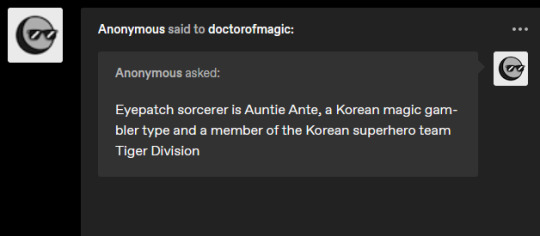
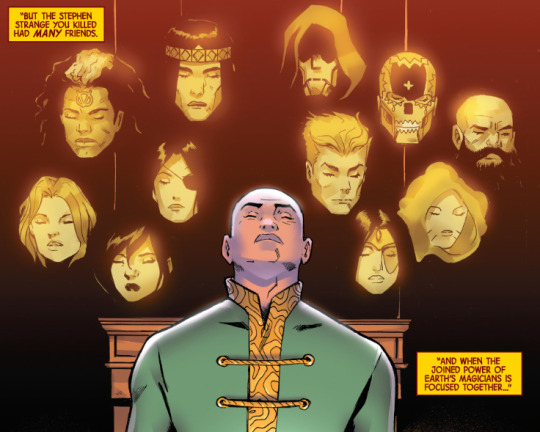
I’ll come back to the differences between 60′s and current Stephen, but this is one of the interesting aspects that allow us to bring light into his character development. Stephen has many friends now, even though he pushes people away. His deeds may stay hidden from most people and heroes, but sorcerers are pretty much aware of his importance. And he met all these people over the years and allowed them to build a safe magic community. And for those who missed the preview post, here are their names: Doctor Voodoo, Shaman, Jennifer Kale (I think?), Auntie Ante, Nico Minoru, Mahatma Doom, Médico Místico, Count Kaoz, Daimon Hellstrom, Professor Xu and Talisman.
The spell is preventing the other Sorcerers Supreme (Aggamon and Tiboro) from escaping to their respective dimensions, for they need them to execute the plan against the Peregrine Child and the Mothers.
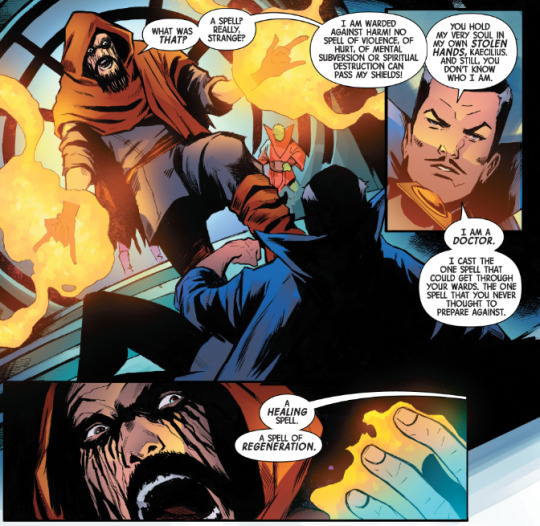
Next, Stephen overcomes Kaecilius not with powerful attacks but a healing spell, which is absolutely in character since Stephen always does that in order to overcome powerful enemies. This is why I love him so much. IT’S NOT ABOUT POWER.
Stephen strangeplains that, since his soul is located in Kaecilius’ stolen hands, the healing spell regenerates his former body entirely. It demands flesh, tho, which kinda reminds me of Fullmetal Alchemist, you know. Very dark spell for 60′s Stephen to perform but hey, Kaecilius saw that coming.
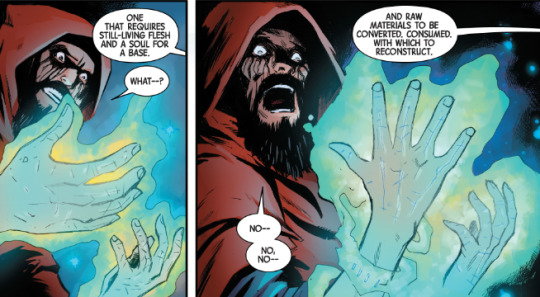
Stephen is not one to be okay with killing his enemies, that much is true. But I consider this one an equivalent exchange. And 60′s Stephen does explain that the kind one who wouldn’t do it is no longer among them.

I think that... Listen, Stephen was supposed to have his hands healed, right? Because continuity and such. But do I care about v5? No. My mistake was to assume that there would be continuity, but I’m just so glad it didn’t because boi, you know the drill. V5 is definitely not my jam. And also, I don’t think this spell healed his hand (you can still see the scars). Instead, it healed Stephen’s “body” by transmuting it.
And so, our beloved Stephen is reborn (for a brief period, at least). He’s so confused haha poor thing. Also always a pleasure to see him in different clothes.

Next, Stephen is contemplating his younger self’s accomplishments while he was gone. It’s funny to see how he says he doesn’t remember being like that, especially the cold aspect of his personality. Mostly because, as you keep reading Stephen’s chronology throughout the years, you start noticing subtle shifts in his subjectivity. The Sanctum starts getting crowded, first with the Defenders, and then with Sara, Imei, Wong and Clea, even Morgana (ew) and Rintrah. For an introvert, he sure had many people around him, and he grows fond of them, no matter how hard he tries to get isolated from time to time (as I always post that panel from New Avengers Annual #2). Stephen is aware of his own growth, as he points out. Even ice can melt, and he doesn’t regret the man he has become. Reckless, depressed, afraid of relying on others? Yes. But also kind, passionate and loved by those around him. I can’t help but wonder what current Stephen would do in his place. Probably a less dramatic sacrifice, but a sacrifice nonetheless.
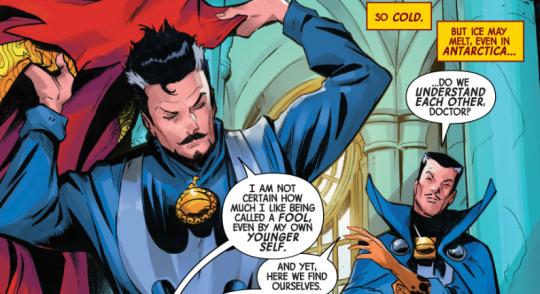
60′s Stephen then makes a demand of current Stephen. We do not know what it is yet, but we’ll find out.

And as I predict, a price will be paid. Because magic comes at a cost. Stephen contemplates Death. She has been chasing him for a while now (that beautiful cover from Doctor Strange v2 #4 is a nice homage), and he always managed to deceive her. But not this time, he’s afraid. Stephen knows the price of magic, he knows the sacrifices he has made in order to protect the world. The same way that he knows that, even though he admires the courage in the Avengers and the X-Men, magic will seal the final battle.
Five Sorcerers Supreme to distract the Peregrine Child. I’m a little bitter here because some time ago I saw discourse on Illyana, saying she isn’t powerful enough to be a sorcerer supreme. Ah, Jed is definitely my vindicator. She’s an X-man too, but look at her, having the spotlight. BECAUSE SHE’S A VERY POWERFUL SORCERESS, THANK YOU VERY MUCH.

Ahem. But back to the chapter. 60′s Stephen’s astral form then confronts the Peregrine Child, as planned. He’s consumed, and yet, he desires to be, for he’s their Trojan horse. The Peregrine Child is a concept that feeds upon magic, right? So imagine all the magic it has stored within? It’s beautiful, really, the way Stephen’s astral form ignites the fire.

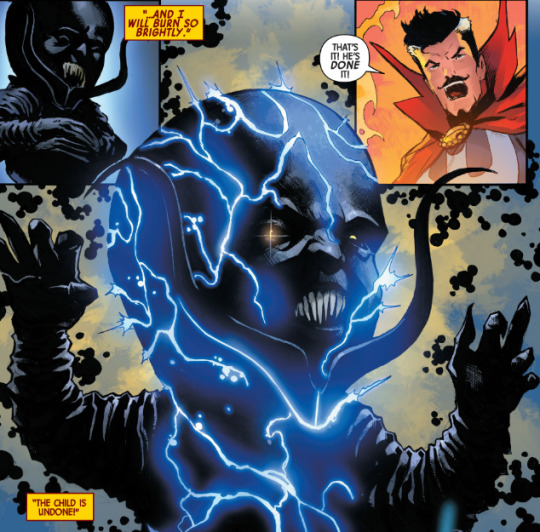
I love these panels. It reminds me of Doctor Strange - The End, in which his sacrifice ignites and restarts magic. It’s beautiful, I really really really adore this.
With 60′s Stephen’s aid, the sorcerers have enough power to banish their enemies across the dimensions before the child detonates. And so they do. The chapter then finally gives us a moment of Stephen and Clea (YES!)
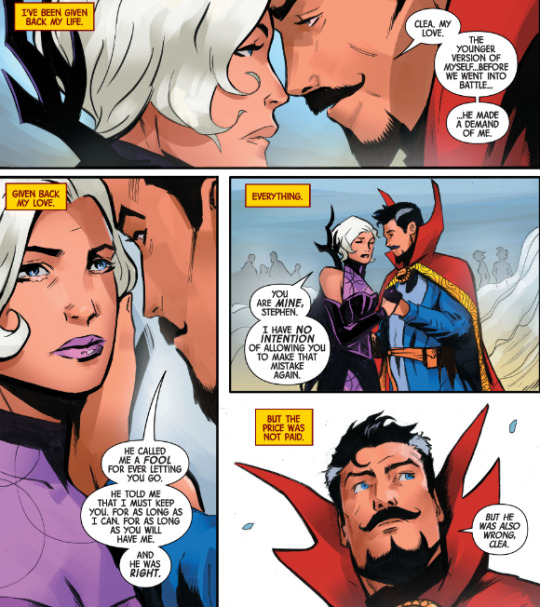
Here we learn what 60′s Stephen demanded of current Stephen. I’ve waited for this moment for SO LONG, since I last read Sorcerer Supreme #67. And I wonder about those who have been reading comics since then, or even before. 30 years!!!! And they finally, finally have a closure!! Literally, Jed can have my whole soul at this point. I’m just so grateful, even though, yes, Stephen is aware that he will not last.


I love how the chapters end with “the beginning” instead of “the end”. Because even though Stephen dies, this is not the end for him. Also it’s a new chapter in Clea’s life.
Stephen is right, though. It’s not fair for them but there’s literally no one else who could fit the job better than Clea. Let me remind people that a Sorcerer Supreme usually has to learn deity magic in order to become more powerful. Who are the four people Stehen has taught this kind of magic in the past? Jericho, Illyana, Victor and Clea. Jericho was once Sorcerer Supreme but the job took its toll on him. Illyana is the SS of Limbo and she cannot leave her realm unattended (things go south there). And lastly, Victor cannot stand the light of the Eye of Agamotto (also he wasn’t featured in DODS, glad to see that he will make an appearance in Strange #1 soon though heh).
It’s “easier” for Clea to leave the Dark Dimension in the meantime while she finds a way to bring Stephen back, not to mention that she was the one who learned the most while living with Stephen.
My heart is full and empty at the same time. Mostly because we have such a sad ending, but we’re also about to get more real soon, and I can’t wait!! One month, folks!
That said, Jed has been a blessing to my fan’s heart and I cannot stress this enough. There’s literally no one else I’d trust more to write Stephen nowadays. I felt it in my bones that he would do an amazing job as soon as I realized how deeply he admired Stephen through Felicia’s POV. He has been teasing his love for the character for a long time now and the fact that he fixed a relationship that has been ruined since the 90′s? That he has been delivering references and writing him exactly the way I see Stephen? That I’m not crazy for overthinking Stephen’s personality because it’s right there in a canon book? Really. I’m so so so so grateful.
My thanks to him, as well as Lee Garbett, Antonio Fabela and everyone involved in this book. This blog will have a quick shift to focus on Clea since she will be featured often in the next book, but this is not a problem since y’all been known my love for her since day 1 hehe.
10/10. A must read for sure!

#doctor strange#stephen strange#clea#clea strange#wong#kaecilius#review#dods#wednesday tomes#marvel comics#jed mackay#lee garbett#antonio fabela
91 notes
·
View notes
Text
The House of D
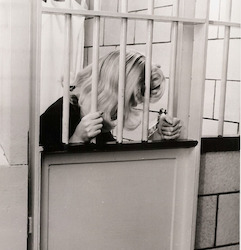
As one of his final acts in office, Mayor Jimmy Walker broke ground in 1932 for the New York City House of Detention for Women, built on the site of the old Jefferson Market jail in Greenwich Village and colloquially known as the House of D. According to sociologist Sara Harris’ Hellhole (on John Waters’ list of recommended reading), It was intended as a model of prison reform. Opened in 1934, the twelve-story monolith of brownish brick with art deco flourishes loomed behind the old Jefferson Market courthouse on Sixth Avenue, looking more like a stylish if somewhat cheerless apartment building than a prison. Windows were meshed instead of barred, and the one sign on its exterior merely gave the address, “Number Ten Greenwich Avenue.” There were toilets and hot and cold running water in all four hundred cells, and it was going to focus on rehabilitating its inmates – prostitutes, vagrants, alcoholics and/or drug addicts – rather than merely punishing them. From the start the reality was at variance with the intentions, and the facility quickly became infamous as a combination of Bedlam and Bastille. Within a decade it was chronically overcrowded with a volatile mix of inmates: women who couldn’t make bail awaiting trials that were sometimes months off, women already convicted and serving time, alcoholics and addicts, the mentally ill, violent lesbian tops, street gang girls, hookers and other lifelong multiple offenders, and teenagers spending their first nights behind bars. Tougher, more experienced prisoners brutalized and sexually assaulted the weak and inexperienced. So, of course, did the staff. The halls rang with the howls of inmates suffering the agonies of drug or alcohol withdrawal. There were cockroaches and mice in the cells and worms in the food. Village lesbians called it the Country Club and the Snake Pit. The IWW organizer Elizabeth Gurley Flynn did time in the House of D, as did accused spy Ethel Rosenberg and Warhol shooter Valerie Solanas. In 1957, Dorothy Day, founder of the Catholic Worker movement, spent thirty days there for staying on the street during a civil defense air raid drill. Her ban-the-bomb supporters picketed outside every day from noon to two; the Times called them “possibly the most peaceful pickets in the city.”
Despite its bland exterior, the House of D made its presence very known in the neighborhood through the daily ritual of inmates yelling out the windows or down from the exercise area on the roof to the boyfriends, girlfriends, dealers and pimps perpetually loitering on the Greenwich Avenue sidewalk – a carnivalesque Village tradition for almost forty years. Waters first caught the spectacle in the early 1960s. “It was amazing. No one can ever imagine what that was like. All the hookers would be screaming out the windows, ‘Hey Jimbo!’ And all the pimps would be down on the sidewalk yelling stuff.” Writer and film producer Jeremiah Newton initially encountered it at around the same time. “It was this huge, monolithic building, looking like the building the Morlocks dragged the Time Machine into, and the girls were always yelling down, screaming obscenities and throwing things out the window. It was the biggest building there. I sat on a stoop watching the people walk by. I’d never seen anything quite like it before.” The Village writer Grace Paley lived near the facility in the 1950s and 1960s, and walked her kids past it regularly. She wrote that “we would often have to thread our way through whole families calling up – bellowing, screaming up to the third, seventh, tenth floor, to figures, shadows behind bars and screened windows, How you feeling? Here’s Glena. She got big. Mami mami, you like my dress? We gettin you out baby. New lawyer come by.”
Women arrested at antiwar rallies during the Vietnam era found themselves locked up in the House of D with the hookers, junkies, crazies and butch lesbians. On Saturday, February 20 1965, two eighteen-year-old college students, Lisa Goldrosen of Bard and Andrea Dworkin of Bennington, were arrested during an antiwar protest at the UN and sent to the House of D. There, they later testified, they were brutally mistreated and humiliated by male doctors “examining” them for venereal diseases, and forced constantly to fend off the rough advances of other inmates. They were not allowed to use a telephone until Monday. That March, the New York Post ran an exposé based on their testimony. They didn’t experience anything other women hadn’t for thirty years by then, but in the 1960s those other inmates were overwhelmingly poor black and Hispanic women. Dworkin and Goldrosen were white, middle-class college coeds. As so often happens, that’s what it took to generate public outrage.
When Grace Paley herself was arrested at another war protest some months later, she was detained in the facility. Conditions had slightly improved in light of the outcry the Post had stirred up. Paley had been arrested before at antiwar protests, but it had always resulted in at worst overnight stays. This time a judge threw the book at her and gave her six days. “He thought I was old enough to know better,” she later wrote, “a forty-five year old woman, a mother and teacher. I ought to be too busy to waste time on causes I couldn’t possibly understand.” At least she could look out her cell window and watch her kids walking to school.
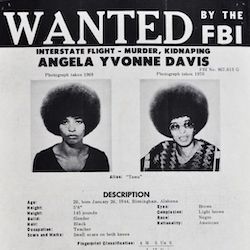
In October 1970, Angela Davis was arrested in the Howard Johnson Motor Lodge at Eighth Avenue and Fifty-First Street and taken to the House of D. It was not her first time in Greenwich Village. She was born in 1944 in Birmingham, Alabama, where her father was a car mechanic and her mother was a teacher and a civil rights activist. They lived in a black neighborhood called Dynamite Hill because the Klan had firebombed so many homes there. With help from the American Friends, she and her mother moved to New York, where her mother studied for her Masters at NYU while Angela attended Elisabeth Irwin High School in the Village. She went on to study philosophy at Brandeis, the Sorbonne, and at the University of California, earning her Ph.D. One of her teachers was Herbert Marcuse. By the late 1960s she was an avowed Communist, a member of the Student Nonviolent Coordinating Committee and affiliated with the Black Panthers. She lectured in philosophy at UCLA until 1969, when her Communist and radical affiliations got her fired.
In August of 1970 a black teen named Jonathan Jackson took over a Marin County courtroom and demanded the release of his older brother, Panther member George Jackson, from nearby Soledad prison. He took the judge, the district attorney and three jurors hostage. In the attempted getaway, Jackson, the judge and one other person were shot and killed. When police discovered that Davis, who knew George Jackson, was the registered owner of Jonathan’s weapon, she was charged as an accomplice to murder, a capital crime in California. She fled the state, which put her on the FBI’s most wanted list. A beautiful twenty-six-year-old with a huge and magnificent Afro, she became a global pop star of the revolution a la Che Guevara. When the FBI arrested her she’d spent a few days walking openly in Times Square, unrecognized because she’d slicked down the Afro and dressed like an office worker.
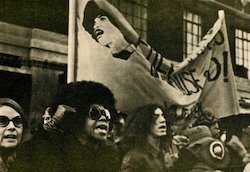
Within thirty minutes of her being locked up in the House of D a crowd of protesters began to gather outside the monolith, chanting; prisoners stood in their windows and chanted along, their fists raised. The NYPD sent a Tactical Defense Force unit – riot police – and House of D officials turned off all the lights inside, hoping to quiet things down. Instead, women set small fires in their cells, and demonstrators cheered the flickerings in the windows. They dispersed without major incident. Placed in isolation, Davis went on a ten-day hunger strike. She spent nine weeks in the facility while fighting extradition to California, where, she was quite convinced, she’d be convicted and put to death. In fact she would be acquitted of all charges in a San Francisco courtroom in 1972, after spending eighteen months behind bars.
Davis was the facility’s last celebrity tenant. Through the 1950s and 1960s, Greenwich Village civic and neighborhood groups had constantly called for the facility to be removed to some location more appropriate, which is to say far away from where they lived and walked their children to school. More liberal souls in the neighborhood thought it should stay, fearing that if the women were shifted to some more isolated location they might be all the more easily mistreated. Before he wrote the hit Broadway musicals Hello, Dolly! and La Cage aux Folles, Villager Jerry Herman wrote a satirical revue called Parade, which included a song about the House of D controversy:
Don’t tear down the House of Detention
Keep her and shield her from all who wish her harm
Don’t tear down the House of Detention
Cornerstone of Greenwich Village charm…
So I say fie, fie to the cynic
Know that there’s love in these hallowed walls of brown
There’s love in the laundry, there’s love in the showers,
There’s love in the clinic
'Twas built with love, my lovely house in town
Save the tramp, the pusher and the souse
Would you trade love for an apartment house?
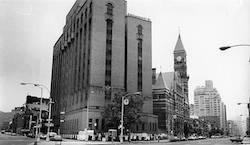
Dworkin and Goldrosen’s testimony before a commission studying conditions at the House of D helped lead to its being shut down in 1971. Inmates were moved to a new facility on Rikers Island. After some debate about possible new uses for the Village monolith, it was simply torn down in 1973. The site is now a small, fenced-in garden. In 1974 Tom Eyen’s spoofy play Women Behind Bars, set in the House of D in the 1950s, premiered. John Waters’ star Divine performed in a later production.
by John Strausbaugh
11 notes
·
View notes
Text

So I guess it’s that time of day where I get up on my soap box to once again talk about the incongruities and gaping chasms in the Netflixvania plot that have yet to be addressed, specifically those that strengthen the case for why shoehorning Leon into this mess divorced of his supporting cast and story is probably a Bad Idea.
TL;DR I am perpetually tortured by the fact nothing makes sense right now so I am going to whinge exhaustively in a post to exorcise myself of misery and potentially spare my poor friend’s ears.
So. The show’s version of the origin story has not been properly detailed in any meaningful length except for the fact that a) Leon is indeed the patriarch of the Belmont family and b) he entered Wallachia specifically to hunt for Dracula. Sounds like the same story beats from LoI at face value, but just like everything else about this house of cards, it completely falls apart under the faintest bit of scrutiny. I’ve beat the dead horse of Mathias no longer being canon enough as it is, but Mathias is arguably the most pivotal character in the entire story. You cannot make a Castlevania adaptation that excludes his history and expect it to make actual sense. If you remove Mathias, you dismantle every facet of the plot in one fell swoop, especially if you’re going to try and wedge Leon Belmont into your story without him. The two are mutually exclusive, you cannot have one without the other unless you completely rewrite the canon to follow a wholly different trajectory that is free of those trappings (i.e Lords of Shadow, which I do not like, but I appreciate that it was trying to do something totally different and therefore don’t take great issue with it.)
And I would have accepted this level of reimagining was the show’s intention, if Leon wasn’t paid such a heaping dose of aggressive lip service to indisputably assert him as this universe’s Belmont patriarch as well. But put in context with the rest Ellis’ interpretation as is, this just ends up making no God damn sense.
Dracula has been explicitly stated to be the first vampire to exist in this universe. That solidly affirms that Mathias is not canon, so therefore Leon’s history with him is also non existent. So in turn, that logically means Walter Bernhard also never existed, Mathias never hatched that elaborate plot with him to betray Leon, Sara was never kidnapped, Leon never had to rescue her, she was never bitten by Walter, her soul was never sacrificed to make the Vampire Killer. So what did happen, then? If Dracula was never Mathias, then what the fuck was he up to in the 11th century? Getting his distance mirror apparently, which he made an oddly specific point of mentioning he acquired 400 years prior to the events of season two, which would have been approximately 1075. This would leave us 19 years prior to Lament of Innocence, so presumably Dracula was already a vampire when Leon was just a child. Which in itself just more effectively dispatches any expectations of their history together being the same or even just similar to what it was in LoI.
Albeit, Trevor treats us to some pretty loaded exposition in saying that the Belmont family hailed from France, moving to Wallachia when “the dark things all moved into the east”--followed by Alucard affirming that Leon was in Wallachia looking specifically for Dracula. So Dracula and his monsters were obviously in France at some point in this canon causing a stink that attracted Leon’s notice--we also have evidence of this with one of the storyboard artists drawing Leon in his knightly garb slaying said monsters. But if Dracula was never Mathias in Ellis’ interpretation, what was he even doing dicking around in France in the first place? And furthermore, what did he do to convince Leon to chase him into the east as well as devote his life and the life of every Belmont after him to killing Dracula specifically? Because it’s gonna be a pretty weak downgrade in motivation from the original story if he just wants to kill Dracula because Vampires Are Evil ™, or Dracula just offhandedly killed someone important to him without nary a drop of history behind them to give it weight.
Also another discrepancy between these two canons is Leon is still a knight when he goes into the east whereas he gave up his knighthood in the games; this is quite boldly showcased by his depiction in that big ass painting as well as the fact his sword is present in the Belmont hold--which is also coincidentally the thing that kills Dracula, not the Vampire Killer. And oh yeah, how the fuck is the Vampire Killer here if the whole plot behind its existence has been effectively erased? I repeat, it’s going to be a weak downgrade if it came from anything less than the tragedy of Sara Trantoul’s sacrifice--which its starting to seem like it will be, based on everything else that’s been exorcised from the show canon.
There’s just no sensible way to knit these two interpretations together at this point if Ellis is going to dig in his heels and maintain that Dracula’s history as Mathias is not part of his vision, so I really can’t say I’m sure what in God’s name he’s going to inject into the story to fill this gaping hole he’s gnawed into the canon. I strongly believe Leon should just have been quietly excluded if the most vital elements of his story have been erased along with Mathias as well. I would not be here complaining about this at all if Leon hadn’t been forced into this version of Castlevania unnecessarily, which then just opened up a black hole of inconsistencies. Why even add him? Why have your main cast keep talking about him? Why sprinkle in fresh lore about him? Why make his sword the thing that kills Dracula? Why do all this if he’s going to be either a non-entity in the future of the show, or you’re going to just ignore the entirety of the canon that he is inextricably attached to?
This is why I’m kind of in a purgatorial relationship with the show right now as we wait for season three; I have no idea if there’s going to be even a molecule of exposition showing off the “New and Improved” vision for Leon’s and Dracula’s backstory--a part of me finds their constant chatter about Leon a little too heavy-handed for his character and history to just be swept under the rug thereafter, but another part of me is pretty solidly convinced the show isn’t even going to attempt to address that elephant in the room from here.
However, if Alucard’s going to be left by his lonesome with nothing but his father’s castle and the Belmont library, then he better be busting his ass down there reading up on some Belmont family history. Because honestly? There really is no other purpose his character can serve when isolated from the rest of the cast, the action and the plot, besides acting as a vehicle for exposition. I’d like to believe that this was the intention behind that very sudden and very off-handed plot point of Trevor bestowing his family’s library upon him in season 2. Why else do that and then just leave him there? If Alucard is just going to be steered back into the fray early into the new season, then what was even the point of having the team go their separate ways?
Anyways. I’ve said before I really wouldn’t mind if the staff decided to rewrite Dracula and Leon’s history together a little due to the bizarre and convoluted nature of LoI’s plot which definitely needs a fresh coat of paint, and I still maintain that; but they seem to be both borrowing the outline of the premise while erasing the primary facets that made it work, and I’m entirely confused about how they’re going to actualise such a shaky narrative structure. Not very well, judging by this janky mess of plotholes they’ve dug for themselves--if they don’t just conveniently forget to ever address it again, I’m half sure their answers to these questions are going to be some wacky nonsense that probably even further diminishes the symbolic importance of the story as a whole.
If the show completely erases any meaningful relationship between Dracula and Leon as well as the gravity behind the Vampire Killer’s origins, then it will have truly sunk to a whole new depth. These are the only things I am begging Ellis not to fuck up. You know, the entire crux of Castlevania’s plot as we know it, and the entire reason this story is even playing out in this universe the way it is.
There’s no shortage of us already frustrated with his treatment of the canon as it is, and its a damn shame. I really like a lot of things about the show. The animation is still gorgeous, the music is wonderful, the atmosphere is great, and I felt genuinely moved by some of the scenes they curated for us. I appreciate the hard work the team as a whole has poured into it in the limited time frame they have to complete every season. There’s no taking away from the fact that the show has value in many areas. But Ellis to date has sadly cocked up more facets of the story than he has improved, which is what is consistently holding the show back. As much as I crave answers from this series though, I’m equally as afraid that I am not going to like them when I get them. Or that Leon’s character is going to get dragged backwards through a thorn-bush should he ever appear in the flesh.
I would love nothing more than season three to blow me away and restore my faith in the future of the series but at this point, I’d honestly settle for a few minutes of icon material and whatever answers there are so I can finally leave this bespoke Silent Hill Ellis’ writing has crafted for me, amen and good night.
#⚜ :: OOC┊Person of Sinterest#{sin complains; the thrilling novel you didnt know you needed}#{you dont need it LMAO BUT I HAVE TO SCREAM INTO THE VOID BC THIS IS DRIVING ME INSANE}#{u know that conspiracy theory meme from always sunny thats me}#{s3 or any consequent seasons will probably never answer my questions tbh ill just have to live here in this hell forever}#{also god damn please just release season 2's ost so i can enjoy that if nothing else}#{i hope s3 airs on my birthday so i can just really be kicked in the balls}
7 notes
·
View notes
Text
Things To Do While Self-Isolating in Chicago: Part 5 — Great Chicago Reads
With tens of millions of Americans suddenly forced to work from home, to stay at home, and to confront the general cleanliness of their homes; this seems like a good time to discuss things to do while self-isolated in Chicago.

The dilemma: You’re sheltering in place and confined to your home just as spring arrives and blooming flowers and trees beckon you to experience Chicago’s myriad sights, sounds and smells. What to do?
A good option is reading one of the excellent books and narratives about the city. There’s an embarrassment of riches when you begin looking at Chicago and the written word. Fear not—we’ve honed the list down to 10 great reads about the city and its architecture.
Sin in the Second City: Madams, Ministers, Playboys, and the Battle for America’s Soul
This tour of Chicago was written by Rick Kogan and illustrated by photographer Charles Osgood. It’s a favorite of Chicago street photographer Rich Kolar. “It’s about the Everleigh Sisters and their ‘gentlemen entertainment establishment,’” Kolar says.
Sidewalks – Portraits of Chicago
Another Kogan/Osgood book recommended by Kolar. “It’s a whole collection of the people who live and work in the neighborhoods of Chicago. You really don’t know Chicago until who know the neighborhoods.”
Chicago: City on the Make
The Nelson Algren narrative comes recommended by Roosevelt University professor Vince Cyboran. It presents 120 years of local history, including the Black Sox scandal, and even long-forgotten local slang.
Sara Paretsky Series
Another recommendation by Professor Cyboran, the Paretsky mystery novels are set in Chicago and feature a private investigator named V. I. Warshawski.
Devil In The White City
The spellbinding semi-fictional historical novel by Erik Larson is set in 1893 Chicago. It uses true tales of Daniel Burnham, the architect behind the Plan of Chicago and the World Columbian Exposition; and Dr. H. H. Holmes, a pharmacist and serial killer who lured his victims to their deaths in his elaborately constructed “Murder Castle.”
Broken Glass
This is a new book by Alex Beam about Mies van der Rohe and the strange case of the Farnsworth House in Plano, Illinois. If you think your apartment or house doesn’t have enough closet space, consider Edith Farnsworth. Mies’ original design had NO closets. Said van der Rohe, “It’s a weekend house. You only need one dress. Hang it on a hook on the back of the bathroom door.”
City of the Century: The Epic of Chicago and the Making of America
This book by Donald L. Miller is the story of the emergence of modern America. It traces the beginning of the city, its politics, growth and disasters like the cholera epidemics and the Great Chicago Fire.
Never a City So Real: A Walk in Chicago
Author Alex Kotlowitz looks at the soul of the city by introducing the reader to some of its most interesting residents. Kotlowitz was not a native Chicagoan, but he found a home here and saw how the city was a refuge of sorts for other outsiders.
Division Street
The Studs Terkel oral history, like Kotlowitz’s account of the city, is based on life stories and personal interviews with 70 residents. Some are rich, others poor, but every one of them has a fascinating tale.
The Chicago Architects Oral History Project
The CAOHP began in 1983 by the Art Institute’s Department of Architecture. The idea was to record the life experiences of architects who shaped the physical environment in Chicago and surrounding communities. You can access the vast library here.
from Chicago Architecture https://www.chicagoarchitecture.org/2020/03/31/things-to-do-while-self-isolating-in-chicago-part-5-great-chicago-reads/
0 notes
Photo

Every October UCF celebrates Diversity Week. This year’s dates are October 16 – 20, and the theme is Transform and Inspire Inclusion. University-wide departments and groups champion the breadth and culture within the UCF community, and work to increase acceptance and inclusion for everyone at UCF and the surrounding communities.
One of the fantastic things about UCF is the wide range of cultures and ethnicities of our students, staff, and faculty. We come from all over. We’re just as proud of where we are from as we are of where we are now.
For information about the Library Diversity Week activities visit: guides.ucf.edu/diversityweek
Join the UCF Libraries as we celebrate diverse voices and subjects with these suggestions (below the keep reading link)
And thank you to every Knight who works to help others feel accepted and included at UCF!
Blindspot: hidden biases of good people by Mahzarin R. Banaji and Anthony G. Greenwald In this accessible and groundbreaking look at the science of prejudice, Banaji and Greenwald show that prejudice and unconscious biases toward others are a fundamental part of the human psyche. Suggested by Sara Duff, Acquisitions & Collections
Creating a World that Works for All by Sharif Abdullah (ebook) The world is a mess. The privileged few prosper. The masses suffer. And everyone feels spiritually empty. Most people would blame capitalism, racism, or some other "ism". But according to Sharif M. Abdullah, the problem is not ideology. It's exclusivity -- our desire to stay separate from other people. In Creating a World That Works for All, Abdullah takes a look at the mess we live in -- and presents a way out. To restore balance to the earth and build community, he says, people must stop blaming others, embrace inclusivity, and become "menders". He outlines three simple tests -- for "enoughness", exchangeability, and common benefit -- to guide people as they transform themselves and the world. Suggested by Schuyler Kirby, Rosen Library
Digital Countercultures and The Struggle for Community by Jessa Lingel Whether by accidental keystroke or deliberate tinkering, technology is often used in ways that are unintended and unimagined by its designers and inventors. Jessa Lingel tells stories from the margins of countercultural communities that have made the Internet meet their needs, subverting established norms of how digital technologies should be used. She examines a social media platform (developed long before Facebook) for body modification enthusiasts, with early web experiments in blogging, community, wikis, online dating, and podcasts; a network of communication technologies (both analog and digital) developed by a local community of punk rockers to manage information about underground shows; and the use of Facebook and Instagram for both promotional and community purposes by Brooklyn drag queens. By examining online life in terms of countercultural communities, Lingel argues that looking at outsider experiences helps us to imagine new uses and possibilities for the tools and platforms we use in everyday life. Suggested by Megan Haught, Teaching & Engagement/Research & Information Services
Dreamland Burning by Jennifer Latham When Rowan Chase finds a skeleton on her family's property, she has no idea that investigating the brutal century-old murder will lead to a summer of painful discoveries about the past... and the present. Nearly one hundred years earlier, in 1821, a misguided violent encounter propels Will Tillman into a racial firestorm. In a country rife with violence against blacks and a hometown segregated by Jim Crow, Will must make hard choices on a painful journey towards self discovery and face his inner demons in order to do what's right the night Tulsa burns. Suggested by Christina Wray, Digital Learning & Engagement Librarian
Every Heart a Doorway by Seanan McGuire Children have always disappeared from Eleanor West's Home for Wayward Children under the right conditions; slipping through the shadows under a bed or at the back of a wardrobe, tumbling down rabbit holes and into old wells, and emerging somewhere ... else. But magical lands have little need for used-up miracle children. Nancy tumbled once, but now she's back. The things she's experienced ... they change a person. The children under Miss West's care understand all too well. And each of them is seeking a way back to their own fantasy world. But Nancy's arrival marks a change at the Home. There's a darkness just around each corner, and when tragedy strikes, it's up to Nancy and her new-found schoolmates to get to the heart of the matter. Suggested by Megan Haught, Teaching & Engagement/Research & Information Services
Furiously Happy: a funny book about horrible things by Jenny Lawson Jenny Lawson is beloved around the world for her inimitable humor and honesty, and in Furiously Happy, she is at her snort-inducing funniest. This is a book about embracing everything that makes us who we are - the beautiful and the flawed - and then using it to find joy in fantastic and outrageous ways. Because as Jenny's mom says, "Maybe 'crazy' isn't so bad after all." Sometimes crazy is just right. Suggested by Megan Haught, Teaching & Engagement/Research & Information Services
Gender Nonconformity and the Law by Kimberly A. Yuracko When the Civil Rights Act of 1964 was passed, its primary target was the outright exclusion of women from particular jobs. Over time, the Act's scope of protection has expanded to prevent not only discrimination based on sex but also discrimination based on expression of gender identity. Kimberly Yuracko uses specific court decisions to identify the varied principles that underlie this expansion. Filling a significant gap in law literature, this timely book clarifies an issue of increasing concern to scholars interested in gender issues and the law. Suggested by Megan Haught, Teaching & Engagement/Research & Information Services
Made by Raffi by Craig Pomranz; illustrated by Margaret Chamberlain As a shy boy, Raffi is a loner and teased at school until one day he discovers knitting and decides to make a scarf for his father and a cape for the prince in the school play. Suggested by Cindy Dancel, Research & Information Services
Symptoms of Being Human by Jeff Garvin A gender-fluid teenager who struggles with identity creates a blog on the topic that goes viral, and faces ridicule at the hands of fellow students. Suggested by Cindy Dancel, Research & Information Services
The Good People by Hannah Kent (on order) Based on true events in nineteenth century Ireland, Hannah Kent's startling new novel tells the story of three women, drawn together to rescue child from a superstitious community. Nora, bereft after the death of her husband, finds herself alone and caring for her grandson Micheál, who can neither speak nor walk. A handmaid, Mary, arrives to help Nóra just as rumours begin to spread that Micheál is a changeling child who is bringing bad luck to the valley. Determined to banish evil, Nora and Mary enlist the help of Nance, an elderly wanderer who understands the magic of the old ways. Suggested by Sara Duff, Acquisitions & Collections
The Bone People: a novel by Keri Hulme Kerewin, a part-Maori painter living in self-exile, is drawn out of her isolation by a mute boy who is cast up on a beach, the only survivor of a shipwreck. Suggested by Sara Duff, Acquisitions & Collections
The Hate U Give by Angie Thomas Sixteen-year-old Starr Carter moves between two worlds: the poor neighborhood where she lives and the fancy suburban prep school she attends. The uneasy balance between these worlds is shattered when Starr witnesses the fatal shooting of her childhood best friend Khalil at the hands of a police officer. Khalil was unarmed. Soon afterward, his death is a national headline. Some are calling him a thug, maybe even a drug dealer and a gangbanger. Protesters are taking to the streets in Khalil's name. Some cops and the local drug lord try to intimidate Starr and her family. What everyone wants to know is: what really went down that night? And the only person alive who can answer that is Starr. But what Starr does or does not say could upend her community. It could also endanger her life. Suggested by Andrew Hackler, Circulation
The Inclusion Breakthrough: unleashing the real power of diversity by Frederick A. Miller & Judith H. Katz The Inclusion Breakthrough cuts a path through this potential minefield, offering a proven methodology for strategic organizational change, including models for diagnosing, planning, and implementing inclusion-focused, culture-change strategies tailored to each organization's individual needs. It also describes the key competencies for leading and sustaining a culture of inclusion. Offering real-world results of ''before and after'' surveys, including anecdotal and statistical reports of organizational change achieved using the methodologies described, Suggested by Sandy Avila, Subject Librarian
The Interrogation of Ashala Wolf by Ambelin Kwaymullina Taking refuge among other teens who are in hiding from a government threatened by their supernatural powers, Ashala covertly practices her abilities only to be captured and interrogated for information about the location of her friends. Suggested by Sara Duff, Acquisitions & Collections
The Rest of Us Just Live Here by Patrick Ness What if you aren't the Chosen One? The one who's supposed to fight the zombies, or the soul-eating ghosts, or whatever the heck this new thing is, with the blue lights and the death? What if you're like Mikey? Who just wants to graduate and go to prom and maybe finally work up the courage to ask Henna out before someone goes and blows up the high school. Again. Because sometimes there are problems bigger than this week's end of the world, and sometimes you just have to find the extraordinary in your ordinary life. Even if your best friend is worshiped by mountain lions. Suggested by Christina Wray, Digital Learning & Engagement Librarian
What if?: short stories to spark diversity dialogue by Steve L. Robbins Hiring and retaining the best and brightest talent is what defines market leadership today. And in the global marketplace winning the war for talent means embracing differences, discovering other worldviews, and reframing our organizations for competitive advantage. What If? delivers a creative and innovative way to explore the issues that dominate today's multicultural workplace: leadership and mentoring, creativity and innovation, organizational culture and engagement. In 25 inspiring stories-some deeply personal-Steve Robbins offers fresh insight into the real and meaningful differences among people and how the power of everyday experiences can be the catalyst for seeing the world through a different lens. What If? also presents specific ideas of what organizations can do toengage our global world, build core competencies in diversity and inclusion, and benefit from the best talent available - regardless of age, gender, ethnicity, religion, race, or disability. Suggested by Sandy Avila, Subject Librarian
What We Left Behind by Robin Talley From the critically acclaimed author of Lies We Tell Ourselves comes an emotional, empowering story of what happens when love may not be enough to conquer all. Toni and Gretchen are the couple everyone envied in high school. They've been together forever. They never fight. They’re deeply, hopelessly in love. When they separate for their first year at college—Toni to Harvard and Gretchen to NYU—they’re sure they’ll be fine. Where other long-distance relationships have fallen apart, theirs is bound to stay rock-solid. The reality of being apart, though, is very different than they expected. Toni, who identifies as genderqueer, meets a group of transgender upperclassmen and immediately finds a sense of belonging that has always been missing, but Gretchen struggles to remember who she is outside their relationship. Suggested by Cindy Dancel, Research & Information Services
Whistling Vivaldi: and other clues to how stereotypes affect us by Claude M. Steele In this work, the author, a social psychologist, addresses one of the most perplexing social issues of our time: the trend of minority underperformance in higher education. With strong evidence showing that the problem involves more than weaker skills, he explores other explanations. Here he presents an insider's look at his research and details his groundbreaking findings on stereotypes and identity, findings that will deeply alter the way we think about ourselves, our abilities, and our relationships with each other. What he discovers is that this experience of "stereotype threat" can profoundly affect our functioning: undermining our performance, causing emotional and physiological reactions, and affecting our career and relationship choices. But because these threats, though little recognized, are near-daily and life-shaping for all of us, the shared experience of them can help bring Americans closer together. In a time of renewed discourse about race and class, this work offers insight into how we form our sense of self, and lays out a plan that will both reduce the negative effects of "stereotype threat" and begin reshaping American identities Suggested by Sara Duff, Acquisitions & Collections
Women and Leadership: transforming visions and diverse voices edited by Jean Lau Chin Over the past thirty years the number of women assuming leadership roles has grown dramatically. This original and important book identifies the challenges faced by women in positions of leadership, and discusses the intersection between theories of leadership and feminism. Suggested by Megan Haught, Teaching & Engagement/Research & Information Services
You're Welcome, Universe by Whitney Gardner When Julia finds a slur about her best friend scrawled across the back of the Kingston School for the Deaf, she covers it up with a beautiful (albeit illegal) graffiti mural. Her supposed best friend snitches, the principal expels her, and her two mothers set Julia up with a one-way ticket to a "mainstream" school in the suburbs, where she's treated like an outcast as the only deaf student. The last thing she has left is her art, and not even Banksy himself could convince her to give that up. Out in the 'burbs, Julia paints anywhere she can, eager to claim some turf of her own. But Julia soon learns that she might not be the only vandal in town. Someone is adding to her tags, making them better, showing offand showing Julia up in the process. She expected her art might get painted over by cops. But she never imagined getting dragged into a full-blown graffiti war. Suggested by Emma Gisclair, Curriculum Materials Center
5 notes
·
View notes
Note
The Blue Danube... Omfg... Do I laugh or do I groan... I never know with this show lol *"nine years" - "the forensic Academy conference?" my teeth are rotting, how can he be so sweet?? Where do they make such people? I mean to just confess something like that out of the privacy of your own head? It's such a long way from where we began...
Do I laugh or do I groan
lmao that is the question, anon. Always. If it’s a great ep, I believe you find yourself doing both at once throughout. Also, bury me w/ that car scene playing on a loop bc dear lord that’s the purest kind of life-giving sweetness there is. And Ecklie - of all people - trying to document GSR w/ Sara oozing 100% unapologetic Attitude and Grissom in his trademark “I’d rather eat glass than talk to you” mood is the most hilarious.
Regardless of how much I trust someone, no way in hell I’m letting a bee to sit on my hand. True brave soul, Sara) And look at the payoff!! I feel like my insides have turned into fluff, I’m sitting here all curled up and the grin on my face is decidedly stupid. They are so sweet! I just can’t believe that I’m seeing this, they are always so quiet and tender with each other! Like when will your faves ever. And just let em kiss you stupid masks!! All the pain and slowest burn were so worth this!!
Ah yesss, the proposal. in the presence of thousands of bees, naturally. “I love it when you dress up.” KILL ME And then back at work they are in this “holy shit, we just got engaged like whattt” haze, it’s AH.M.A.Z.I.N.G.GG
God it’s so fucking hard to watch Sara “I’ll punch you in the face, I’ll physically fight you or at least shout some hard truth at you” Sidle, my passionate emotional girl, being so done with everything. And that letter scene really didn’t help. I mean it so beautiful in a soul-crushing kind of way. You take all the time you need girl, but I’ll miss you terribly!! On another note, that tiny girl is even creepier that before
That’s the PTSD-fueled burnout, and things only get darker at the end of this season. They really follow through w/ the aftermath of individual trauma and how it can effect a couple dynamic. It gets mixed into existing issues and creates an arc that’s (imo) both difficult and rewarding to watch unfold.
Aww another lab specialists - centric episode, they’re all so cute)) and everyone being so sweet trying to support Grissom (although he is probably not having a good day, what with talking about his personal life more in one day than his entire life before that). Anyway I’m really glad that they know about them, can you imagine how isolating it would be for her to leave while no one had a clue how personal it was for him? *sorry I’m in a weird existential mood today*
No worries, I’m in a “weird existential mood” my whole life, anon. Yeah, poor guy’s trying to bury himself in work and it won’t lead to anywhere pretty. But Hodges and his “murder game” oddly help ease the misery and gives us that surprisingly touching “you’re not ready to leave yet” moment, so from this aspect, it’s good that they know about the relationship. It makes this “connecting” possible.
But I also think it makes things v awkward w/ the rest of the team and I love that too?? Grissom dislikes being scrutinized and he esp dislikes it when ppl stare at him knowingly. There’s an episode where the killer attacks him and grabs him by the neck, and it leaves a nasty, painful bruise. Catherine and the killer’s sister comment on his injury w/ sympathy, but he swats Cat’s hand away, pulls his collar up, then starts wearing a scarf bc he just can’t stand that kind of attention. I think the same thing is going on here. He is in pain and everybody knows exactly why and they keep trying to help and he keeps trying to avoid that.
I love how all the “regular remedies” offered by them - “talk about it”, “go after her”, “hang w/ us” - have precisely one effect: it triggers his flee mode. Despite the obvious good intentions, the others just don’t know what to do w/ Grissom and he just hides in his office, trying to find a way - his way - out of this hell by himself (the way Sara is doing it off screen), and once again if that’s not something from the “relatable AF” box, I don’t know what is.
3 notes
·
View notes